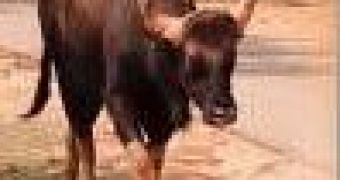When kouprey (Bos sauveli) (foto) was first discovered in 1937 by French naturalists, the news provoked a sensation. An almost one tonne beast hidden from science till the middle of 20th century! Shrouded in mystery, this rare ox with dramatic, curving horns has been an icon of Southeast Asian conservation, included in the IUCN's Red List of Threatened Species. Feared extinct, it's been the object of perilous expeditions to the region's jungles by adventurers, scientists and journalists.
Recently, Northwestern University biologists and a Cambodian conservationist present compelling genetic evidence that the kouprey may never have existed as a wild, natural species.
The researchers compared a published DNA sequence from the kouprey with sequences obtained from a true Cambodian wild ox, the banteng (Bos javanicus). The researchers had predicted, based on a study of kouprey anatomy, that the kouprey was a hybrid form and would show mitochondrial DNA similar to that of the banteng. The prediction was confirmed by their analysis.
The kouprey, which is now the national animal of Cambodia, may have originated as a domestic hybrid, between banteng and zebu cattle (Bos taurus indicus), that later became wild. ("Kouprey" means "forest ox" in the Khmer language.)
"The kouprey has acquired a rather romantic, exotic reputation," said Gary J. Galbreath, senior author of the paper and associate director of Northwestern's Program in Biological Sciences. "Some people would understandably be sad to see it dethroned as a species."
But, added Galbreath, "It is surely desirable not to waste time and money trying to locate or conserve a domestic breed gone wild. The limited funds available for conservation should be used to protect wild species." Galbreath has been traveling to Southeast Asia studying its animals since 1999.
So, kouprey has in fact a status similar to the mustangs of USA, which are nothing more than domestic horses run wild.
Ironically, Galbreath initially began his work in Southeast Asia in the hope of identifying a new species of bear. It proved to be an unknown golden color phase of the Asiatic Black Bear (Selenarctos thibetanus).
He was also involved in solving the enigma of another alleged new species of ungulate, the "khting vor", that was only known to science from its horns. Galbreath and others showed that these horns were the work of human artisans and the "khting vor" was a fake.
Instead of finding new species, Galbreath said, "I've been involved in showing that two named species of large mammal may never have existed as such." But, he notes, "In the end, good science is about what is true, not what is desired to be true."
Galbreath hopes the paper will serve to focus conservation time, dollars and attention on real species that need saving. "The definitely real wild oxen of mainland Southeast Asia -- Banteng, Gaur (Bos gaurus), wild Water Buffalo (Bubalus bubalis) - could soon become extinct if more is not done to protect them from rampant poaching," Galbreath said. "I hope that the publicity from the kouprey story can help make people aware of this problem."

 14 DAY TRIAL //
14 DAY TRIAL //